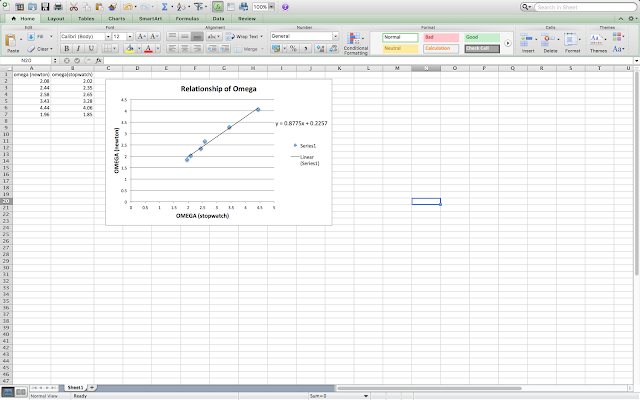Centripetal Force with Motor
Samuel
Ellis
Mia
10-3-2016
Purpose:
To determine the relationship between angular frequency to angle at which it swing.
Theory:
When an object is spinning, there will be a centripetal force acting on the object. In addition, faster the spin is, the higher the object will be. Since centripetal force is increasing, the force in y-component is also increasing. In result, object will increase in height. We can use height, angle and time to determine it velocity.
Procedure :
1. An electric motor mounted on a surveying tripod.
2. A long shaft going vertically up form the shaft.
3. A horizontal rod mounted on the vertical rod.
4. A long string tied at the end of the string.
5. A ring stand with a horizontal piece of paper or tape sticking out.
6. Start motor, and make sure object hit the paper.
7. Record height of paper and time for 10 rotation.
7. Increase speed and repeat same procedure.
List/Data:
(1)
t = 31.06 sec
h = 63 cm
(2)
t = 26.75 sec
h = 92.3 cm
(3)
t = 23.7 sec
h = 102.3 cm
(4)
t = 19.16 sec
h = 144.3 cm
(5)
t = 15.46 sec
h = 167.8 cm
(6)
t = 34.00 sec
h = 51.5 cm
Calculated Result:
H = 203.8 cm
R = 70 cm
L = 185.1 cm
h_initial = 127.6 cm
θ_initial = 43.57 degree
ω = θ/t = (2*π*10)/t
T*sin(θ) = m*r*ω^2
/ T*cos(θ)= m*g
_______________________
Tan(θ) = (r*ω^2)/g
Sqrt((g*tan(θ))/r) = ω
ω
2.08 2.02
2.44 2.35
2.58 2.65
3.43 3.28
4.44 4.06
1.96 1.85
 |
| (Above is the graph of ω(stopwatch) vs. ω(height) graph. By plotting omega time verse omega height, we can linear fit the slope and get the resulting angular velocity(0.8775)) |
Conclusion:
This experiment is based on centripetal force and its angular velocity. We first set motor to same voltage, which gave consistent velocity to spinning object. Then used paper as a hit point to see what's the resultant height of different centripetal forces. There's a little different between calculated value and actual value. My first assumption is air-resistant, we did not include air-resistant into our experiment. Air-resistant depend on size and speed of the object, bigger or faster the object, more air-resistant will have. Since we kept on increasing the spinning velocity, which increase it force. Then the air-resistant will also increase, result in little different from calculated value from actual value. Also, human error, the measuring tool we used to measure the height is regular ruler. There might be slight error from human eyes based on different angle from what he/she viewed.




No comments:
Post a Comment